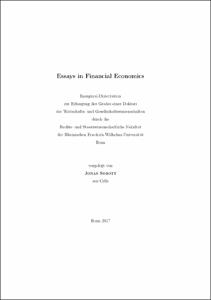Sobott, Jonas: Essays in Financial Economics. - Bonn, 2017. - Dissertation, Rheinische Friedrich-Wilhelms-Universität Bonn.
Online-Ausgabe in bonndoc: https://nbn-resolving.org/urn:nbn:de:hbz:5-48178
Online-Ausgabe in bonndoc: https://nbn-resolving.org/urn:nbn:de:hbz:5-48178
@phdthesis{handle:20.500.11811/7086,
urn: https://nbn-resolving.org/urn:nbn:de:hbz:5-48178,
author = {{Jonas Sobott}},
title = {Essays in Financial Economics},
school = {Rheinische Friedrich-Wilhelms-Universität Bonn},
year = 2017,
month = jul,
note = {This dissertation consists of four chapters.
In the first chapter, I analyze strategic underreporting of market risk for a sample of North American and European Banks from 2002 to 2014. In particular, the chapter examines whether banks used modelling leeway in the calculation of the diversification effect to report a lower market risk. Value-at-Risk (VaR) and the deviation thereof from an empirical counterfactual is used as proxy for underreporting of market risk. The counterfactual is constructed based on broad asset class VaR and the correlation of indices tracking the broad asset classes (Perignon and Smith, 2010). Underreporting is identified by exploiting variations in the incentives to report a lower risk, namely equity scarcity and potential penalties.
The second chapter examines the effects of the Dodd-Frank Act on credit ratings. The evolution of credit rating levels is evaluated against the movement of market-implied default probabilities as counterfactual. In line with existing literature – namely Dimitrov et al. (2014) – I document a decrease in the rating levels after the Dodd-Frank Act. However, this finding is not robust and sensitive to specification changes. The second part of the chapter documents that the effects of the Dodd-Frank Act are not limited to rating levels, but also affect the informational value of rating reports, a brief explanation stating the reasoning behind the decision. Using natural language processing tools, I detect a more ambiguous language for rating reports on entities with a low rating after the Dodd-Frank Act.
In the third chapter, we document the transition of banking in Central and Eastern Europe to market-oriented banking systems that are largely free of government influence. Commonly, the success is attributed to foreign ownership. However, during the crisis, foreign banks were a source of the transmission of financial fragility. In this chapter, we argue that the quality of banking institutions – i.e. of credit institutions and the legal and regulatory structure – is an important determinant of the success of a banking system. In particular, our empirical analysis shows that the crisis shock had a smaller impact on loan growth in countries with credit registers or bureaus for the recording of loans.
The fourth chapter compares the speed with which information are compounded into equity and CDS prices in a lead-lag setup. Though equity prices generally incorporate information faster than CDS spreads, there is substantial heterogeneity both between companies and over time. The difference in speed is related to a set of CDS liquidity and trading measures. Although liquidity and trading appears to drive the price discovery process, the actual effect is inconsistent and depends strongly on the actual specification.},
url = {https://hdl.handle.net/20.500.11811/7086}
}
urn: https://nbn-resolving.org/urn:nbn:de:hbz:5-48178,
author = {{Jonas Sobott}},
title = {Essays in Financial Economics},
school = {Rheinische Friedrich-Wilhelms-Universität Bonn},
year = 2017,
month = jul,
note = {This dissertation consists of four chapters.
In the first chapter, I analyze strategic underreporting of market risk for a sample of North American and European Banks from 2002 to 2014. In particular, the chapter examines whether banks used modelling leeway in the calculation of the diversification effect to report a lower market risk. Value-at-Risk (VaR) and the deviation thereof from an empirical counterfactual is used as proxy for underreporting of market risk. The counterfactual is constructed based on broad asset class VaR and the correlation of indices tracking the broad asset classes (Perignon and Smith, 2010). Underreporting is identified by exploiting variations in the incentives to report a lower risk, namely equity scarcity and potential penalties.
The second chapter examines the effects of the Dodd-Frank Act on credit ratings. The evolution of credit rating levels is evaluated against the movement of market-implied default probabilities as counterfactual. In line with existing literature – namely Dimitrov et al. (2014) – I document a decrease in the rating levels after the Dodd-Frank Act. However, this finding is not robust and sensitive to specification changes. The second part of the chapter documents that the effects of the Dodd-Frank Act are not limited to rating levels, but also affect the informational value of rating reports, a brief explanation stating the reasoning behind the decision. Using natural language processing tools, I detect a more ambiguous language for rating reports on entities with a low rating after the Dodd-Frank Act.
In the third chapter, we document the transition of banking in Central and Eastern Europe to market-oriented banking systems that are largely free of government influence. Commonly, the success is attributed to foreign ownership. However, during the crisis, foreign banks were a source of the transmission of financial fragility. In this chapter, we argue that the quality of banking institutions – i.e. of credit institutions and the legal and regulatory structure – is an important determinant of the success of a banking system. In particular, our empirical analysis shows that the crisis shock had a smaller impact on loan growth in countries with credit registers or bureaus for the recording of loans.
The fourth chapter compares the speed with which information are compounded into equity and CDS prices in a lead-lag setup. Though equity prices generally incorporate information faster than CDS spreads, there is substantial heterogeneity both between companies and over time. The difference in speed is related to a set of CDS liquidity and trading measures. Although liquidity and trading appears to drive the price discovery process, the actual effect is inconsistent and depends strongly on the actual specification.},
url = {https://hdl.handle.net/20.500.11811/7086}
}






